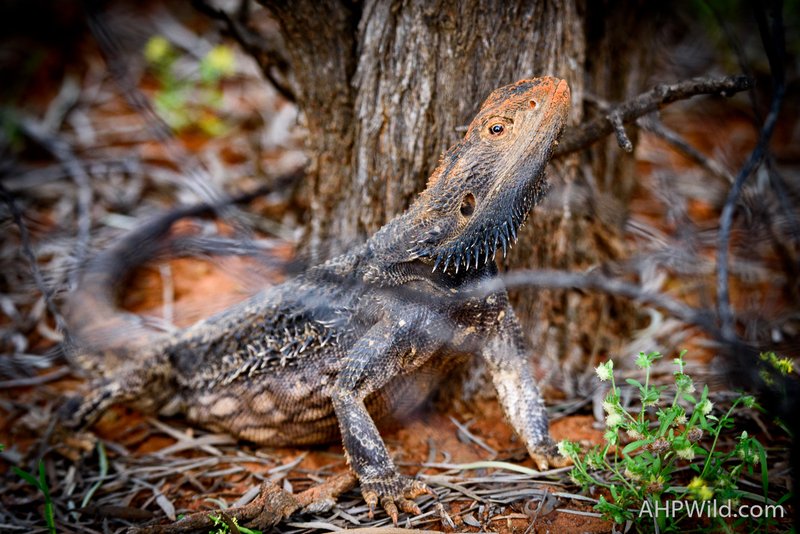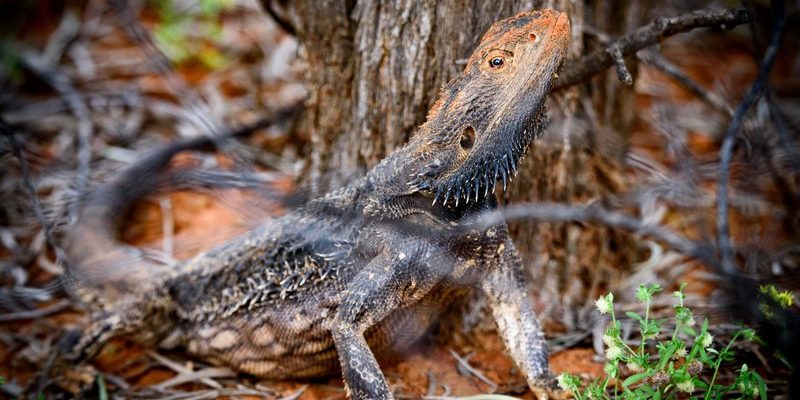
The Central Bearded Dragon, affectionately known as the “beardie,” is a fascinating and popular pet among reptile enthusiasts. With their unique appearance and friendly demeanor, these lizards have gained a special place in the hearts of many. Imagine a little dragon, basking under a warm light, its beard puffing out with character—it’s hard to resist their charm! They originate from the dry savannas and woodlands of Australia, where they thrive in warm climates, making them quite the adaptable species.
One of the things that makes Central Bearded Dragons so intriguing is their ability to communicate through body language. From their distinctive beard that changes color to their head-bobbing displays, they have a lot to say without uttering a single word. Whether you’re considering one as a pet or simply curious about them, you’ll find that learning about their behaviors and care is as engaging as watching them explore their surroundings.
Habitat and Distribution
Let’s first dive into where these fascinating creatures call home. The Central Bearded Dragon can be found throughout the arid regions of central Australia. They prefer habitats that provide ample sun exposure, like open woodlands and scrublands. In their natural environment, these lizards love basking on rocks and branches, soaking up the sun for warmth. This behavior is vital for their health, as it helps regulate their body temperature.
Interestingly, these dragons have adapted well to human environments. In the wild, they establish territories, often staking out areas where they can bask and hunt for food. They can be quite adventurous, climbing trees and shrubs to survey their surroundings. If you ever get the chance to observe one in the wild, you might notice them darting around, showcasing their agility and speed.
Physical Characteristics
Central Bearded Dragons are not just another lizard; they possess some striking physical features. Typically, they measure around 18 to 24 inches in length, including their tail. Their bodies are stout and robust, covered in rough, spiky scales, which can act as a natural defense mechanism against predators.
One of their most defining features is their “beard.” This area under their chin can puff out and change color, often turning black when they feel threatened. It’s almost as if they have a built-in mood ring! The coloration of bearded dragons can vary widely, with hues ranging from browns and yellows to vibrant reds and oranges, depending on their environment and genetics.
Diet and Feeding
When it comes to food, Central Bearded Dragons are omnivores, meaning they eat both plants and animals. In the wild, their diet consists of a variety of insects, fruits, and leafy greens. Crickets, roaches, and mealworms are often their favorites. If you’re planning to keep one as a pet, you’ll need to replicate this diverse diet to keep them healthy.
Feeding them a balanced diet is crucial for their growth and overall wellbeing. As hatchlings, bearded dragons require more protein in the form of insects. As they mature, it’s essential to introduce more vegetables. Leafy greens such as collard greens, kale, and dandelion greens should be staples in their diet. Some owners even enjoy creating colorful salads for their pet dragon, making mealtime not only nutritious but visually appealing!
Behavior and Temperament
Central Bearded Dragons are known for their gentle disposition. They’re typically calm and friendly, making them ideal pets for beginners. If you’ve ever held one, you know how they tend to relax in your hands, basking in the warmth of your body. This laid-back attitude contributes to their popularity among reptile enthusiasts.
Interestingly, these lizards exhibit a range of behaviors that can be quite entertaining. They are curious creatures, often exploring their environment and interacting with their human companions. You might encounter them performing head bobs or arm waving, which are forms of communication. These actions can convey anything from friendliness to dominance, depending on the context.
Care and Maintenance
Caring for a Central Bearded Dragon requires attention to their habitat, diet, and overall health. They need a spacious enclosure with plenty of hiding spots and climbing opportunities. A terrarium with a size of at least 40 gallons is ideal for adults. Ensure that their habitat mimics their natural environment, with warm basking spots and cooler areas for them to retreat to.
Temperature is crucial for their wellbeing. The basking spot should be around 100 to 110 degrees Fahrenheit, while the cooler end should be between 75 to 85 degrees. Proper lighting is also crucial; bearded dragons need UVB light to help them synthesize vitamin D3, which is vital for calcium absorption. Regular monitoring of their environment will help keep them healthy and happy.
Health and Lifespan
On average, Central Bearded Dragons can live up to 10-15 years in captivity if properly cared for. Regular vet check-ups are essential to monitor their health. Common issues include metabolic bone disease, which can occur if they don’t get enough UVB light or calcium in their diet. Being attentive to their needs and noticing any changes in behavior can help catch health problems early.
Maintaining a clean habitat is equally important. Regularly remove uneaten food and waste, and ensure that their living space is sanitized. With the right care and attention, your bearded dragon can thrive and become a cherished companion for many years.
Breeding and Reproduction
If you’re curious about how these little creatures reproduce, it starts with mating season, which usually occurs in spring. After a successful courtship, females lay eggs, often producing clutches of 15 to 30 eggs. These eggs require specific humidity and temperature levels to incubate properly, typically for about 50 to 70 days.
Once the eggs hatch, the tiny hatchlings are independent and ready to fend for themselves. They need a diet high in protein to support their growth, alongside appropriate heating and lighting. Breeding can be a complex process, so if you’re considering this, do plenty of research to ensure you’re prepared for the responsibilities that come with it.
Interesting Facts
Did you know that Central Bearded Dragons can change their color? This ability helps them regulate their temperature and communicate with other dragons. Darker colors absorb more heat, while lighter colors reflect sunlight. It’s a fascinating survival mechanism that highlights their adaptability.
Another fun fact is that these lizards can whip their tails in defense. When threatened, they may puff up their beards and wave their arms to make themselves appear larger. This behavior not only intimidates potential predators but also showcases their unique personality traits.
| Common Name | Central Bearded Dragon |
| Scientific Name | Pogona vitticeps |
| Size | 18-24 inches |
| Diet | Omnivorous |
| Lifespan | 10-15 years |
| Habitat | Woodlands, scrublands in Australia |
| Temperament | Friendly, calm |
The Central Bearded Dragon is more than just a pet; it’s a companion that brings joy and curiosity into our lives. From their intriguing behavior to their colorful personalities, they never cease to amaze. Whether you’re considering adopting one or simply learning about them, understanding their needs and characteristics will enrich your experience. These little dragons are a delightful reminder of the wonders of the natural world.
FAQ
What temperature should I keep my Central Bearded Dragon’s habitat?
Maintaining the right temperature is crucial for your bearded dragon’s health. The basking area should be between 100 to 110 degrees Fahrenheit, while the cooler side should range from 75 to 85 degrees. This temperature gradient allows your dragon to regulate its body temperature effectively.
Do Central Bearded Dragons make good pets for children?
Yes! Central Bearded Dragons are known for their friendly and calm demeanor, which makes them excellent pets for families, including those with children. They are generally easy to handle and can adapt well to being handled regularly. Always supervise young children when they interact with pets to ensure both the child and the dragon are safe.
How often should I feed my Central Bearded Dragon?
Feeding frequency depends on the age of your dragon. Young bearded dragons should be fed daily, while adults can be fed every other day. It’s essential to provide a variety of insects and vegetables to ensure a balanced diet. Keep an eye on their weight and adjust feeding schedules accordingly.
What kind of lighting is best for a Central Bearded Dragon?
Your bearded dragon needs access to UVB lighting to synthesize vitamin D3, which is necessary for calcium absorption. A good quality UVB bulb should be provided for 10-12 hours per day. Additionally, a heat lamp is needed to create a basking area, ensuring your dragon can regulate its body temperature.
Can I handle my Central Bearded Dragon often?
Yes, handling your bearded dragon regularly is important for building trust and affection. They often enjoy being held and will become more accustomed to human interaction over time. Just be gentle and calm, as sudden movements can startle them.
What are the signs of health problems in a Central Bearded Dragon?
Watch for changes in behavior, eating habits, or physical appearance. Signs of health issues may include lethargy, weight loss, or abnormal feces. If you notice anything unusual, it’s always best to consult a veterinarian who specializes in reptiles.
How can I keep my Central Bearded Dragon active and entertained?
Provide a spacious habitat with climbing structures, hiding spots, and enrichment toys. Regular interaction and play outside of the enclosure can also help keep your bearded dragon active and stimulated. You might even consider creating a small obstacle course for them to explore!
Can Central Bearded Dragons live with other reptiles?
While some owners may attempt to house bearded dragons with other reptiles, it’s generally not advisable. Different species can have varied care needs and temperaments, which can lead to stress or aggression. It’s best to keep bearded dragons alone or with carefully selected companions of the same species.
What substrate is best for a Central Bearded Dragon’s enclosure?
Choosing the right substrate is important for your dragon’s comfort. Options like reptile carpet, paper towels, or tiles are recommended, as they are easy to clean and safe. Avoid loose substrates like sand, as they can be ingested and lead to health problems.
How can I tell the sex of my Central Bearded Dragon?
Determining the sex of your Central Bearded Dragon can be tricky. Males typically have larger bodies and more pronounced “beards” that puff up, especially during mating season. Additionally, males may have more pronounced femoral pores. For accurate sexing, you might need to consult with a knowledgeable breeder or veterinarian.

